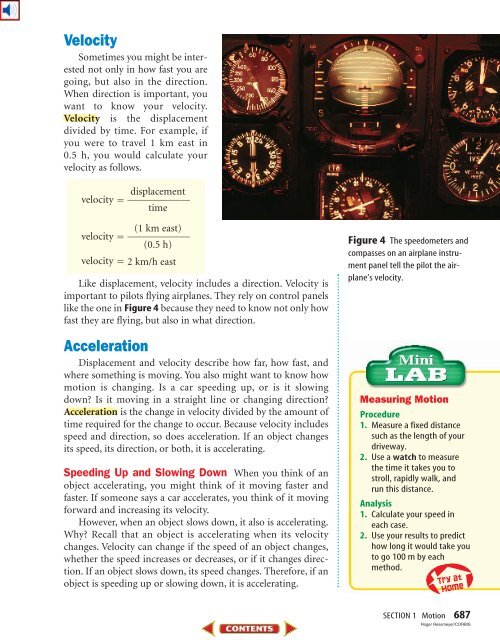Chapter 23: Newton's Laws of Motion
Chapter 23: Newton's Laws of Motion
Chapter 23: Newton's Laws of Motion
Create successful ePaper yourself
Turn your PDF publications into a flip-book with our unique Google optimized e-Paper software.
Velocity<br />
Sometimes you might be interested<br />
not only in how fast you are<br />
going, but also in the direction.<br />
When direction is important, you<br />
want to know your velocity.<br />
Velocity is the displacement<br />
divided by time. For example, if<br />
you were to travel 1 km east in<br />
0.5 h, you would calculate your<br />
velocity as follows.<br />
displacement<br />
velocity <br />
time<br />
(1 km east)<br />
velocity <br />
(0.5 h)<br />
velocity 2 km/h east<br />
Like displacement, velocity includes a direction. Velocity is<br />
important to pilots flying airplanes. They rely on control panels<br />
like the one in Figure 4 because they need to know not only how<br />
fast they are flying, but also in what direction.<br />
Acceleration<br />
Displacement and velocity describe how far, how fast, and<br />
where something is moving. You also might want to know how<br />
motion is changing. Is a car speeding up, or is it slowing<br />
down? Is it moving in a straight line or changing direction?<br />
Acceleration is the change in velocity divided by the amount <strong>of</strong><br />
time required for the change to occur. Because velocity includes<br />
speed and direction, so does acceleration. If an object changes<br />
its speed, its direction, or both, it is accelerating.<br />
Speeding Up and Slowing Down When you think <strong>of</strong> an<br />
object accelerating, you might think <strong>of</strong> it moving faster and<br />
faster. If someone says a car accelerates, you think <strong>of</strong> it moving<br />
forward and increasing its velocity.<br />
However, when an object slows down, it also is accelerating.<br />
Why? Recall that an object is accelerating when its velocity<br />
changes. Velocity can change if the speed <strong>of</strong> an object changes,<br />
whether the speed increases or decreases, or if it changes direction.<br />
If an object slows down, its speed changes. Therefore, if an<br />
object is speeding up or slowing down, it is accelerating.<br />
Figure 4 The speedometers and<br />
compasses on an airplane instrument<br />
panel tell the pilot the airplane’s<br />
velocity.<br />
Measuring <strong>Motion</strong><br />
Procedure<br />
1. Measure a fixed distance<br />
such as the length <strong>of</strong> your<br />
driveway.<br />
2. Use a watch to measure<br />
the time it takes you to<br />
stroll, rapidly walk, and<br />
run this distance.<br />
Analysis<br />
1. Calculate your speed in<br />
each case.<br />
2. Use your results to predict<br />
how long it would take you<br />
to go 100 m by each<br />
method.<br />
SECTION 1 <strong>Motion</strong> 687<br />
Roger Ressmeyer/CORBIS

















